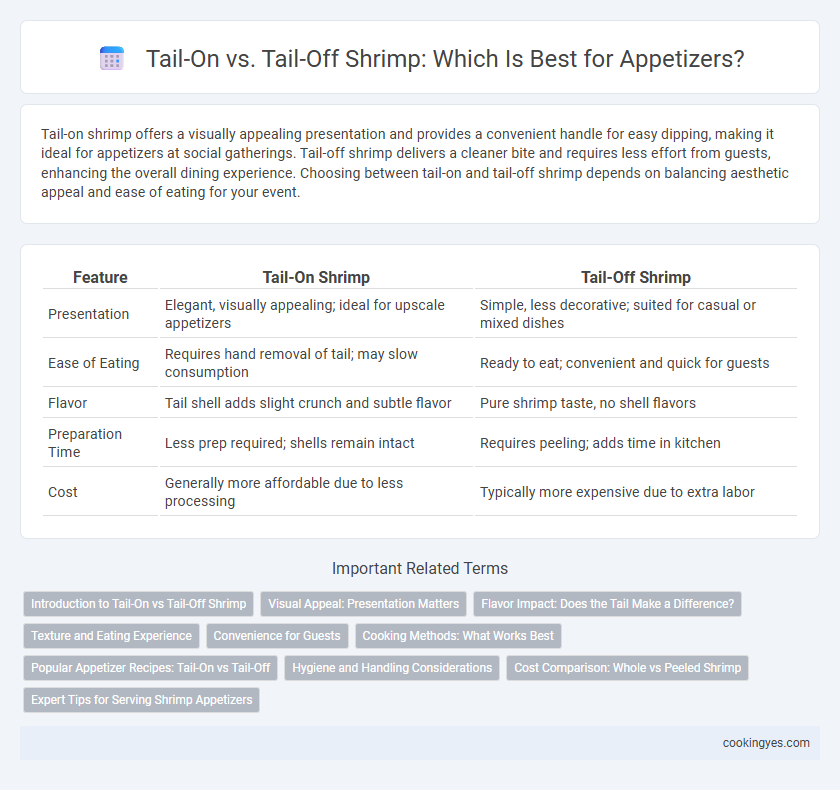Tail-on shrimp offers a visually appealing presentation and provides a convenient handle for easy dipping, making it ideal for appetizers at social gatherings. Tail-off shrimp delivers a cleaner bite and requires less effort from guests, enhancing the overall dining experience. Choosing between tail-on and tail-off shrimp depends on balancing aesthetic appeal and ease of eating for your event.
Table of Comparison
| Feature | Tail-On Shrimp | Tail-Off Shrimp |
|---|---|---|
| Presentation | Elegant, visually appealing; ideal for upscale appetizers | Simple, less decorative; suited for casual or mixed dishes |
| Ease of Eating | Requires hand removal of tail; may slow consumption | Ready to eat; convenient and quick for guests |
| Flavor | Tail shell adds slight crunch and subtle flavor | Pure shrimp taste, no shell flavors |
| Preparation Time | Less prep required; shells remain intact | Requires peeling; adds time in kitchen |
| Cost | Generally more affordable due to less processing | Typically more expensive due to extra labor |
Introduction to Tail-On vs Tail-Off Shrimp
Tail-on shrimp appetizers offer a visually appealing presentation and a convenient handle for dipping, enhancing the overall dining experience. Tail-off shrimp provide ease of eating without the need to discard shells, making them ideal for quick, mess-free consumption. Choosing between tail-on and tail-off shrimp depends on the desired balance between presentation and convenience in appetizer servings.
Visual Appeal: Presentation Matters
Tail-on shrimp offer a visually striking presentation that enhances the appeal of appetizers by showcasing the shrimp's natural shape and color, making dishes more elegant and inviting. The presence of the tail creates a convenient handle for guests, improving ease of eating while maintaining a sophisticated look. Conversely, tail-off shrimp provide a cleaner, minimalist appearance suitable for mixed dishes but lack the dramatic, eye-catching effect crucial for upscale appetizer displays.
Flavor Impact: Does the Tail Make a Difference?
Tail-on shrimp retain natural juices and impart a slightly sweeter, oceanic flavor, enhancing the overall taste profile of appetizers. Tail-off shrimp offer convenience but may lose some moisture and subtle briny notes during cooking. Choosing tail-on shrimp elevates flavor intensity and presentation, making them ideal for gourmet and visually appealing dishes.
Texture and Eating Experience
Tail-on shrimp offers a firm, satisfying texture that enhances the overall eating experience by providing a natural handle, making them ideal for appetizers served at parties or events. Tail-off shrimp deliver a cleaner bite and quicker consumption, preferred in dishes where ease of eating is prioritized over presentation. Choosing between tail-on and tail-off shrimp depends on whether texture and a tactile experience or convenience and simplicity are more important for the appetizer setting.
Convenience for Guests
Tail-on shrimp offer guests an authentic dining experience with enhanced texture and flavor, but can be less convenient due to the need for peeling. Tail-off shrimp provide ease of eating and reduce mess, making them ideal for quick, bite-sized appetizers at social events. Selecting tail-off shrimp improves guest convenience and enhances overall enjoyment during casual gatherings.
Cooking Methods: What Works Best
Tail-on shrimp retain their natural moisture and flavor during grilling or sauteing, making them ideal for high-heat cooking methods that preserve texture. Tail-off shrimp excel in boiling or steaming, allowing for easy seasoning absorption and faster cooking times. Choosing the right cooking method enhances the shrimp's taste and presentation in appetizers.
Popular Appetizer Recipes: Tail-On vs Tail-Off
Tail-on shrimp retain their shells and tails, offering a crunchy texture and enhanced flavor, making them ideal for popular appetizer recipes like shrimp cocktails and tempura. Tail-off shrimp provide easier eating and cleaner presentation, preferred in dishes such as shrimp salads and bruschettas where convenience is key. Choosing between tail-on and tail-off shrimp depends on the balance between flavor intensity, texture, and guest convenience in appetizer preparations.
Hygiene and Handling Considerations
Tail-on shrimp offer better hygiene by minimizing direct contact with the edible portion, reducing contamination risks during handling and serving. Tail-off shrimp require careful handling to prevent foodborne pathogens since the exposed meat is more susceptible to contamination. Proper sanitation protocols and handwashing are essential to maintain safety with tail-off shrimp in appetizer preparation.
Cost Comparison: Whole vs Peeled Shrimp
Tail-on shrimp typically cost less per pound than peeled shrimp because they require less processing, making them a budget-friendly option for appetizers. Peeled shrimp demand higher prices due to the added labor and packaging involved in removing shells and tails. Choosing between whole and peeled shrimp depends on cost considerations balanced with convenience and presentation preferences for appetizer menus.
Expert Tips for Serving Shrimp Appetizers
Tail-on shrimp enhances presentation and offers guests a convenient handle, making them ideal for upscale appetizers at events. Expert tips recommend serving tail-on shrimp chilled with zesty sauces like cocktail or garlic aioli to elevate flavor and maintain texture. For casual gatherings, tail-off shrimp simplifies eating, allowing for easy dipping and snacking without sacrificing taste or quality.
Tail-on vs tail-off shrimp for appetizers Infographic

 cookingyes.com
cookingyes.com